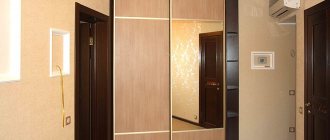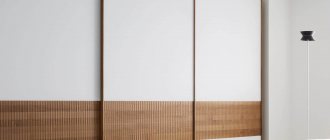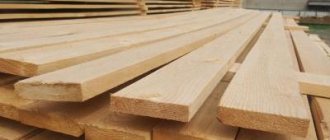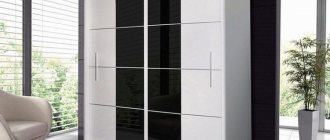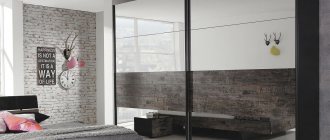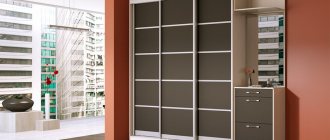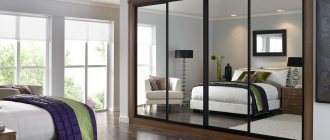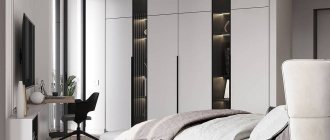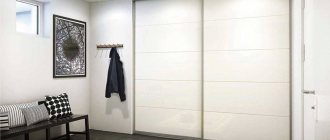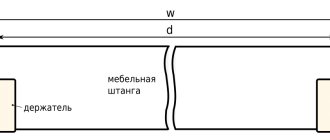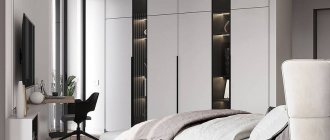Updated: November 4, 2022
A sliding wardrobe is an excellent modern storage system. In addition, it perfectly decorates the interior. We will talk about the types of wardrobes, their features and use in the living room, bedroom, nursery and hallway. Let's look at photos of 100 ideas for wardrobes in the bedroom and hallway.
- In the living room
- Mirror and stained glass
- Price of sliding wardrobes to order
Advantages and disadvantages of built-in wardrobes
Built-in furniture has many advantages:
- significant space savings due to sliding doors;
- due to the fact that there is no need to make the back and side walls, an order of magnitude less material is consumed, which significantly reduces the cost of the finished product;
- the ability to perfectly fit the element anywhere in the apartment;
- with similar dimensions, greater capacity than a free-standing piece of furniture;
- variety of design options;
- internal content is created to suit the needs of a specific person or family;
- the widest selection of manufacturing materials and design;
- almost unlimited functionality;
- behind the surfaces of the structure it is easy to hide unsightly internal parts: pipes, meters, columns, ventilation ducts, etc.
But there are a number of disadvantages:
- In order for the furniture to look beautiful and not have any distortions, the place where construction is planned must have smooth walls, a floor, and all angles must be strictly 90 degrees;
- when installing in a room where suspended ceilings are planned to be installed, additional guide beams for doors will be required;
- when moving, you will not be able to take the product with you; when remodeling, you will be able to move it to another corner;
- A poor-quality sliding door system can quickly fail, resulting in further wastage of time and material.
Advantages
Sliding wardrobes 2022 have undoubted advantages over their “brothers” with hinged doors:
- ergonomics is the main plus, it meets all human needs, saves space, while accommodating a maximum of things;
- aesthetic appearance - the ability to use various design solutions and styles;
- variety of models - a huge selection of materials, fittings, decorative elements;
- functionality – the possibility of internal filling, organization of internal space and configuration;
- reasonable price due to “built-in” - no side or rear walls, ceiling or floor.
Selection rules
To make your new cabinet spacious, attractive and durable, before going to a furniture showroom, it is advisable to follow a few simple rules:
- take all measurements - built-in models are rarely bought ready-made;
- pay attention to the contents: calculate where various items will be stored and what the optimal height of the shelves will be;
- In order for the cabinet to stand correctly, it is necessary to check the uniformity of all walls;
- choose the type of facade - it is what families will see every day - product options are presented in the photo;
- choose high-quality fittings - this is where the product will last a long time.
It’s worth stocking up on a lot of ideas to find out which model will fit perfectly into your living room. The more carefully the built-in wardrobe is thought out, the better the result will be. Be sure to leave room for additional shelves in case you need to add more clothes.
Types of sliding wardrobes
Built-in wardrobes of the “compartment” type are made to order, based on the size and configuration of the room.
They are distinguished according to the following parameters:
- installation location;
- fastening method;
- material of manufacture;
- fastening type;
- project characteristics;
- design decoration;
- Number of doors.
The door opening mechanism can be supported or hinged. The load-bearing version is reliable, able to withstand heavy loads, in the lower part there are rollers on which the door moves. In the hinged version, there are rollers on top - the door here should be as light as possible.
According to model design
Cabinet designs are different:
- linear - the product is placed along the wall, adjacent to a corner or does not significantly reach it, built into a niche (two corners are involved here), can be trapezoidal;
- corner - can be L-shaped, that is, consisting of two cabinets connected to each other, triangular, pentagonal - with side shelves;
- beam - mounted in a corner, less often - on a wall, the facade can be rounded - convex or concave. The product is difficult to manufacture and install, since the costs will be slightly higher than for simpler options;
- combined - this design is similar to a wave, it is quite large, it is installed in spacious rooms, decorating them.
By number of doors
The number of doors is calculated based on the size of the structure. The fewer doors, the easier and more convenient it is to use the locker. The standard door width is 55-75 cm. The overlap of sliding doors is at least 5-7 cm. The most popular models of two-door wardrobes are sliding or hinged doors. Single door ideas are items that are partially open or have only one pocket door. In a cabinet with three doors, in addition to products with a large number of doors, the number of vertical compartments is made one for each door.
By installation method
Coupes are installed in various ways, on which the technical characteristics of the finished structure depend:
- built-in - it does not have side walls, covering and floor, instead of all this there are permanent surfaces of the room. The space here is used to maximum advantage. The product is built into a niche completely covered by a facade with doors - there should be no gaps;
- semi-built-in - installed along a wall or in a corner, has one or two side walls, the “insides” of such a cabinet are mounted directly on the main or internal wall. The design provides additional sound insulation of the rear space;
- suspended: the design gives the impression of doors “floating” in the air, the sliding mechanism of which is not visible;
- floor - refers to cabinet furniture, is located on the floor, does not reach the ceiling a little, and is not attached to the walls of the room.
Cabinets with mirrors: 5 beautiful examples
view album in new window
In the photo: Fashionable interior in shades of gray
Additionally, we will consider options for mirror design of facades of various types of bedroom furniture. Look at the photos below that we took from our portfolio.
Mirrored wardrobe for a bedroom in art deco style
view album in new window
In the photo: Bedroom wardrobe with drawers at the bottom
A charming version of a light wardrobe with drawers and stunning mirror fronts.
Beautiful and bright bedroom interior with built-in wardrobe
view album in new window
In the photo: Fashionable interior design in white and peach tones
Another very beautiful built-in wardrobe with Gothic glazing.
Neoclassical style cabinet for multifunctional storage
view album in new window
In the photo: Luxurious wardrobe with a chest of drawers in neoclassical style for the bedroom
In this interior, the closet is not only a place for super-multifunctional storage, but also a real work of art.
Modern wardrobe in gray for the bedroom
view album in new window
In the photo: Modern interior in monochrome white and gray tones
A universal solution for any modern style in apartment interior design.
Types of door opening mechanisms
When choosing a built-in wardrobe, you should pay attention not only to the size and design, but also to the door opening mechanism. They are made in the form of a compartment, a swing door, an accordion. Each option has performance characteristics.
Coupe
If you need a wardrobe for installation in a Khrushchev building, it is better to choose the option with sliding doors. The uniqueness of the system is that other furniture can be placed next to the product: the doors do not need space to open, they move to the side and do not open forward. The service life of doors depends on the material used to make the guides. Steel will last no more than 7-10 years, and aluminum - up to 25 years. There are 3 types of mechanisms:
- Hanging system. Equipped with rollers: upper and lower support. The profile is usually made of aluminum. The door closer ensures soft closing of doors.
- Roller system. If configured correctly, the doors will never close spontaneously. The flaps move easily, no effort is required. Such a system can be connected to a remote control.
- Coplanar. This is a modern mechanism that allows the doors to move in complete silence. In this case, the leaves are located in the same plane.
The main advantage of the coupe is that the doors do not take up space. The disadvantage is that such systems are more expensive than swing systems. You cannot install handles on the doors you like. One door always slides behind the other, so it is impossible to open the cabinet completely to inspect all the shelves at once.
Swing
Swing design is a traditional option. This is a simple mechanism that costs less than a coupe or accordion. The doors open forward. Advantages - such doors last a long time and allow you to immediately inspect all the shelves in the closet. The downside is that you need space to open the doors. It is recommended to install hanging furniture in spacious rooms.
Harmonic
Such systems have an important advantage - the fronts fold completely, so you can immediately inspect all the shelves. The door moves along the top guide. The advantage is that the door cannot damage the floor. The installation mechanism is simple, even a beginner can handle it. The disadvantage of the product is that a cabinet with lattice doors requires some free space in front.
Ideas for placing a built-in wine cellar in your home, useful tips
Combined
There are combined door options. For example, sliding doors can be combined with a section in which swing doors are installed. Or swing varieties are made in combination with an accordion. Typically, such systems are used in spacious, linear, built-in or interior cabinets.
Examples of location in the hall
Most popular accommodation options:
- In the corner. By installing a cabinet with such a specific configuration, it is possible to rationally use a corner in the room and significantly save usable space in it, which is especially appropriate for small rooms.
- The entire wall. A solid structure located along the entire wall is a fairly practical and simple way to store a large number of things.
- Around the doorway. This furniture set with a mezzanine practically merges with the doorway, has a very original appearance, excellent spaciousness and undoubtedly becomes the main interior decoration.
- Around the window. It is an indispensable solution that allows you to unload the room, give it comfort, coziness and order. In addition, cabinets around the window provide the opportunity to convert the space under the window opening into a desk, desk or cozy sofa.
- Into the niche. This arrangement is used most often. Cabinets that fully match the depth and configuration of the niche fit perfectly into the recess and save free space in the room.
The photo shows a hinged TV cabinet located on the entire wall in the living room interior.
If there is a fireplace in the living room, cabinets can be installed on the wall adjacent to it. In this case, it is important that the furniture does not stand out too much from the general background, but only complements the interior concept.
The photo shows a window opening in a small living room, surrounded by bookcases.
Also, similar products are often used for zoning a room in a one-room apartment. A tall structure installed in the right place will help divide the space into several functional areas.
Creating a Project
designing a wardrobe is quite simple, especially with the help of modern computer programs in which all calculations are made automatically. Having the necessary skills, you can make drawings and diagrams with your own hands.
You can also use examples with photos, on the basis of which parts are made, after which they are connected to each other into a single structure. It is advisable to think about the design of future furniture simultaneously with the formation of the project.
The project itself consists of parts:
- a general view of the future cabinet, represented by a photograph or a regular drawing that can be drawn by hand or on a computer;
- drawings, and one of them should contain the entire product, and separate drawings are also created for important parts of the cabinet, which are the most significant and difficult to create;
- material cutting map, presented in the form of sheets;
- if the sliding system itself is made by hand, then the profile parts are necessarily formed;
- list of necessary fasteners and accessories.
All these documents have their own purpose and are jointly presented by the corresponding project. They must be created taking into account numerous requirements, since the errors they contain lead to the fact that the resulting cabinet will have distortions or other defects.
Frame
Follow the drawings very carefully, because then you will have to assemble the cabinet exactly according to them. Decide what items you are going to create a wardrobe for. Measure them and designate a place for them in your closet. A project is drawn up in which all the elements of the wardrobe are drawn.
The design of a sliding wardrobe certainly includes the design of the body, which is the most significant element of this piece of furniture. Photos of sample drawings can be seen below. When creating a diagram, the main parameters that the cabinet should have are taken into account:
- width - calculated based on the space allocated for installation of the structure. If it is mounted in a special niche, then when taking measurements it is necessary to obtain information about its width, and the cabinet should have an indicator slightly lower so that there are no obstacles when installing it in this niche. Usually, for this purpose, 5 cm is subtracted from the width of the niche. This allows you to obtain a special technological gap that facilitates the installation or disassembly of furniture;
- depth - this indicator of the body also depends on measurements taken in the early stages of work. The optimal value is considered to be a depth in the range from 60 to 70 mm, but if the room is too narrow, the figure can drop to 35 cm. This value is optimal for children's wardrobes. If the user is an adult, then for rational use of the internal space it is advisable to make wardrobes 55 cm deep;
- height - the Pythagorean theorem is used to calculate it, since cabinets are bulky structures, so they are usually assembled on the floor and then raised into a finished form, therefore, so that during this process the furniture does not rest against the ceiling, it is necessary to correctly calculate the diagonal of the side wall . In addition, when choosing height, the user’s height and his preferences in relation to this indicator are taken into account. It can be from 1.5 to 2.4 m.
The above parameters are fundamental for the cabinet body. In this case, it is necessary to decide what design will be created and what materials will be used in the work.
How to correctly measure a niche for a cabinet
Sliding system
To get a properly designed wardrobe, much attention is paid to calculations and selection of the sliding system. There are several such systems, differing in cost, rules of creation, nuances of use and other parameters.
When designing such a system, its main features are taken into account:
- profile strength, which depends on the material used, since wood or iron, as well as aluminum can be used for this, and the wall thickness additionally affects the strength, so this parameter is calculated based on the planned loads on the system;
- lining according to the profile, on which the presence of veins, bulges or other defects is not allowed; its design may be different, but it must suit the color scheme of the room and the design direction chosen in the room;
- the reliability of the roller, which is the weakest point of the entire system, is considered an important parameter, so it is necessary to purchase only high-quality elements, as well as correctly calculate their installation locations along with the guides, as distortions lead to a decrease in their duration.
Most sliding systems consist of two guides along which rollers move. The most popular systems are:
- roller - a special suspension is attached to the top of the doors, additionally fixed by a roller shoe. This mechanism can be suspended or maintained. Thanks to this design of the system, its silent use is guaranteed;
- frameless: you don’t need to spend a lot of money to create them. It is represented by a chipboard panel, not framed by a steel profile. Rollers are attached to the doors from the bottom and top. Due to constant exposure, the chipboard sheet quickly deforms, so the system is considered short-lived;
- frame - steel or aluminum, the latter option being very expensive. Aluminum structures can easily withstand high loads and other impacts;
- systems specifically designed for radial cabinets. They are presented with a curved profile, relevant for interiors that use non-standard and curved shapes and interior items.
Below you can view photos of different sliding systems, and the choice of this design depends on the financial capabilities and wishes of the users.
Door calculation
Filling
How to design a wardrobe taking into account all the nuances? It is important to understand not only the case of the sliding system, but also the content of the structure. There are many different storage systems that can be used for this furniture, and the following nuances are taken into account when designing:
- a distance of at least 30 cm is left between the shelves, but when creating a wardrobe, users independently determine this parameter, which depends on what exactly will be on a particular shelf;
- if there is a compartment for hooks, its depth should not be less than 55 cm;
- it is decided how many boxes are needed, the diagram marks their location, as well as their size and depth;
- To fill the wardrobe, various additional elements are selected, which include various pull-out nets, baskets, hangers designed for ties, a pantograph or narrow compartments for shoes, as well as built-in ironing boards or other similar items.
Filling is considered an important step in the design of a future wardrobe, although it can always be changed a little if necessary.
Cabinet destination
The room in which it will be located most often determines its purpose, because it is an extremely utilitarian item. The design can be absolutely anything.
Wardrobe for any room
Let's start with the most common request - “cabinet design in interior photo”. This request most often means models that will fit in any room, be it a bedroom, office or living room. Let us give several examples of such universal samples.
For almost any room, options for storing books are suitable, which differ from a rack or shelf in the presence of doors. Usually they are hinged, the doors are complemented with glass inserts. Behind the transparent glass, you can easily see the spines of books and select the one you need, but at the same time, much less dust accumulates on books and shelves. You can often find options with combined doors, when only half of the door is glass, and the other is solid. This is a very convenient solution if you plan to use it to store both books and other items. Our selection of photos of cabinet design for a room will tell you which model may be optimal in which room.
For collectors, models are available with a special coating on the glass that blocks ultraviolet radiation and prevents book covers from fading. Another distinctive feature is the presence of shelves that can be installed at different heights. This can be useful when publications differ greatly in format.
In terms of exterior design, bookcases come in a variety of styles. You should not think that, due to their specifics, they are all performed only in the classical conservative form.
The bookcase design photo above reflects the current trend of giving classic-finished designs a more modern, simple shape.
Models in a modern style are distinguished by greater simplicity of shape, geometricity, and the use of modern materials and technologies. Decorative elements are usually restrained or may be absent altogether. The color scheme and colors can be very different: from classic brown-beige wood textures to specific neon shades. Often there is a combination of different textures or colors. For example, wood-look surfaces can be adjacent to plastic panels.
Developing new designs, Mr. designers Doors primarily proceeds from the most current aesthetic ideas into which the furniture should fit, be it Scandinavian minimalism with light colors or the rich dark colors inherent in the loft style. Both the appearance, functionality and internal content of the models depend on the chosen direction.
Photo of the design of modern light cabinets. The set presented in this interior is distinguished by its simplicity of form and functionality. The minimalist solution is emphasized by the absence of decorative elements. Even the handles have a hidden mechanism.
Several photos of modern cabinet designs are presented below.
It is also convenient to use corner models. They are very roomy, but do not take up much space.
Photos of corner design ideas can be found in our article. But before moving on to the appearance, let’s dwell on the design features, which often determine how the final product will look.
By design, cabinets can be either built-in or cabinet-mounted. Depending on the design of the doors, there are both swing and compartment versions. Their main difference is in shape. The photo of the design of corner cabinets presented below shows all the variety of shapes.
L-shaped. Essentially, these are two products connected to each other.
Diagonal. In this case, the furniture occupies the entire space of the corner.
Radial. The doors of these options are made in a semicircle, which looks very original.
Combined.
Photo of the design of corner cabinets in the room:
Living room cabinets
Traditional slides and solid walls are far from the only option if you are choosing furniture for the living room or hall. Just enter the query “wardrobe in the living room design photo”, and you will see what a variety of models exist today. Today, useful space in the living room is used to store a variety of things: for example, you can install a compartment here that will serve as an additional wardrobe. This is where you can put away items that are used from time to time, such as seasonal clothes or a guest set of blankets, pillows and linens.
If you prefer furniture in a more modern spirit, pay attention to the minimalistic and functional Mr. Doors that do not look bulky and will harmoniously fit into the current interior. Photos of the design of living room wardrobes made in this style can be seen below.
Bedroom wardrobes
First of all, of course, wardrobes or wardrobes are selected for the bedroom. These models today are distinguished by a wide variety of shapes, colors and configurations.
Below are photos of wardrobe designs that reflect the most popular trends.
- Classic. These models gravitate towards traditional forms, proven over centuries. The materials used for finishing are light colors and brown-beige colors. Decorative elements are usually discreet and elegant. An example of such an interior from Mr. Doors is featured below.
- Minimalism. Furniture in this style is characterized by simplicity and geometric shapes. There is often no decor at all. Even the handles can be made in the form of cutouts and be integral with the surface of the door. The color scheme is usually monochromatic. White, gray, black colors are often used.
- Scandi. This style also leans towards minimalism. As you can see from the interior design below, it features a slightly warmer color scheme. There are often elements with light wood decor. Decorative elements and fittings are discreet, simple in shape. The functionality of objects is valued above all else.
- Loft. The best examples of this style combine the brutality of industrial elements and the sophisticated playfulness that is inherent in this direction. You can often find a wardrobe or closet that looks quite rough and at the same time stylish. Textures like untreated wood and metal are often used as coatings. The color scheme is designed in dark, gray tones with the addition of deep shades of blue, red, and green.
- High tech. Ultra-modern style that is the first to respond to all technological innovations. Furniture made in this style is made from modern materials: glass, plastic, metal. There is often backlighting.
If space in the bedroom is limited and the hinged design is not suitable, then you can pay attention to coupe models with sliding doors.
Wardrobes for children's rooms
Children's wardrobes differ in purpose just like their adult counterparts, only their functions may be slightly different. For example, in addition to a wardrobe for clothes, a child needs somewhere to store toys, books, school supplies or creative materials.
Whatever option you choose for the nursery, you should be guided by several principles:
- Safety. All furniture for children must have appropriate certificates. The use of toxic materials is unacceptable.
- Functionality. A children's room should be comfortable for its little inhabitant. Therefore, it is worth taking a closer look at models that will suit your child’s height. Today there is a large selection of so-called “growing furniture” that can be changed and expanded as the child grows.
- Practicality. The creative impulses of young artists are not always limited to a sketchbook; any piece of furniture can suffer. Therefore, you should give preference to models that can be washed. You can also choose product options whose doors are covered with a special film on which you can draw with chalk.
Photos of the design of children's wardrobes for rooms located below are distinguished by bright colors. This is not surprising, because for the proper development of a child it is very important that his own space is filled with a cozy and joyful atmosphere.
Kitchen cabinets
Kitchen cabinets come in a wide variety of design features depending on their functional purpose. Most often, to create a comfortable and convenient space, combinations made up of different types of options are used:
- Floor units serve not only for storage, but also as a work surface. In addition, built-in household appliances are stored in floor cabinets. They are durable and stable and structurally are little susceptible to changing fashion trends.
- Wall units are designed for storing frequently used items, such as tableware and daily food items. Recently, many designers are abandoning upper structures in favor of open shelves and rails, or trying to combine them with traditional designs. Photos of the design of the upper kitchen cabinets, which are presented below, reflect this trend.
- Corner cabinets for the kitchen can be either wall-mounted or floor-mounted. They are great space savers, taking up space that would otherwise be empty. Thanks to modern rotating shelves, using them has become much more convenient.
- Pencil cases are designed for storing food supplies. They can also be used to hide a built-in refrigerator.
- The kitchen island deserves special attention; let’s look at it in more detail. In fact, this is also a floor cabinet or several cabinets, but they are not located along the wall, but in the center of the room, and therefore have a slightly different design. At the bottom there are open or closed storage shelves that serve as a frame to support the tabletop. The tabletop is usually made with some offset for greater convenience. According to its purpose, a kitchen island can combine several functions. For example, a work surface, sink, dining area, bar counter, etc. This solution is designed to significantly reduce the time spent moving around a traditional kitchen unit. In addition, the kitchen island is convenient for the whole family to cook at.
Hallway cabinets
Hallway cabinets should combine compactness and functionality, because usually these rooms in our homes have a very modest area. In this case, narrow and tall compartment options are well suited, which can simultaneously serve as both a wardrobe and a shoe rack. And mezzanines are suitable for storing rarely used items. This solution will help remove things from open hangers and give the hallway a neat look.
Another practical option is cabinets with mirrors. In addition to their main function, they can also serve to slightly expand the space visually. Modern designers are happy to use this technique to decorate small spaces. Photos of the design of cabinets with mirrors in various styles are presented below.
There are often models that combine both of these advantages.
Built-in wardrobe in the living room: design features
The appearance and dimensions of the furniture depend on the features of the interior. The company produces both narrow and wide classic-style cabinets (rectangular) and round, with open shelves, niches for tables or TVs. Models are equipped with mezzanines (for example, for installation near the door) and other structural elements. In houses with open-plan living rooms, custom-shaped cabinets are installed: under the stairs with storage compartments, open shelves, drawers, etc.
Features of choosing a cabinet for the living room
Since the living room is the largest room in the apartment and can combine a dining room, a second bedroom or an office, the choice of furniture should be approached especially carefully:
- When selecting this furniture element, first of all, take into account its dimensions and the parameters of the room.
- It is desirable that the cabinets be combined with the interior style not only in decor, but also in materials.
- In a small living room, you should not use large models that take up space. It is better to place a narrow cabinet-case, compact mini-structures here, or place hanging products.
- For a small square-shaped room, it is recommended to place the wall cabinets higher, almost under the ceiling.
Ideas for different rooms
Bedroom
The bedroom has all your clothes, as well as extra towels, sheets, blankets and pillows. When planning the internal content of the built-in wardrobe in the bedroom, you need to take this into account and place space for bulky items, for example, a duvet will not fit on a standard shelf.
Also, if possible, it is worth organizing a separate place to store all the necessary clothing care items, perhaps for an iron, ironing board or equipment that has nowhere else to be stored. Any model is suitable in size: from the most compact 100 cm wide to a three-meter design with 4 doors, depending on the area of the room.
Children's
The compartment in the nursery is usually shaken for growth. Even if the child is still small and has few things, you can store sheets, towels, various accessories and even toys inside.
When planning the internal contents of a closet in a child’s bedroom, it is important to consider one fundamental point: whether you want the little owner of the room to have access to things or not. Most likely, sooner or later a child will be able to open the doors, so if you are going to store toys with small parts inside that cannot be taken unattended, place them on top. If you are teaching your child independence and order, let all his things be in the lower compartment with free access.
Hallway
In the hallway, any storage system essentially replaces a pantry. What to consider?
- There will be a minimum of everyday items, mostly just outerwear - they are heavy and bulky, so the depth of the body should be enough to accommodate hangers, and the bar should support the weight of furs and coats.
- Instead of shallow shelves, it is better to make large compartments, since suitcases, bags, sports equipment and, possibly, large equipment, such as a washing machine or vacuum cleaner, will be stored here.
- Consider there is enough space for your shoes. Drawers, open shelves or a shoe rack built into the design are suitable. It is advisable to organize a small area nearby for storing shoe care products.
Features of living room cabinets
There are a huge number of features that seem to be just a living room closet.
Check them out to get an idea of its various functions:
- The main function is storage. This is truly the main feature and function of the cabinet. Where else if not to store your shoes of various types, from winter boots to summer sneakers, from unused items to towels. Therefore, shelves must be made in such a way that they can store a large number of things.
- Wardrobes can be multifunctional and store not only clothes, but also other things that are useful to you in everyday life. Vacuum cleaner and other items that take up a lot of space.
- The cabinets are made from quality materials, which will give you a long service life.
- You can choose a cabinet with a seating area. This is suitable if your closet has a hole for a window. This is very convenient and saves space.
- If your room is small, then there are compact options for narrow cabinets that will allow you not to take up much space.
The right wardrobe can make your living room more aesthetically pleasing and beautiful. Moreover, the comfort of the room and the spaciousness of the space depend on the closet.
Color and style
Depending on the style of the living room interior, you should choose the design of the built-in wardrobe itself. Its color will be determined based on the requirements of the overall design. Below are the different options and styles:
- classic - performed mainly in light shades: white, beige, sand and lemon. Part of the facade can be glass or mirror. Manufacturers often equip doors with plastic inserts in gold or silver;
- Baroque, Rococo, Classicism, Empire. Historical styles are also suitable for decorating the living room interior, so the built-in wardrobe will have elaborate gilded facades, an abundance of mirrors and expensive accessories. Sandblasting with floral motifs is often used on the mirror surface. The colors of this style are beige, sand, brown;
- minimalism, hi-tech - a striking feature of such models is the contrasting use of color. Often this is a classic combination of black and white, stripes and diagonals. Often there are no visible accessories in the closet, and the surface of the doors is glossy. Below is a photo of a built-in wardrobe for a living room in a minimalist style.
Ethnic interiors feature motifs on the façades, while Gothic features sharp edges and dark colors.
What are cabinets made of?
The materials from which the cabinets are made should ensure not only the good appearance of the furniture, but also their long service life.
The main materials from which cabinets are made are: wood, metal, plastic, and various types of wood boards.
Let's take a closer look at the features of each of them:
- Wood is considered a traditional material for making furniture. It gives a more aristocratic look to the furniture compared to other materials. It is worth saying that this is an environmentally friendly material of natural origin that will serve you for a long time. Typically, wood materials are used to make expensive cabinet models.
- Plastic – there are these types of cabinets. They don't look as good as wood. In addition, their service life is shorter, but this material does not absorb any foreign odors and does not accumulate dust. This option is also worth considering because it is not that expensive.
- Metal – cabinets made from this material are quite heavy, but very wear-resistant. Traditionally, metal material is combined with other materials. Or they are added as an inclusion.
Today it is quite fashionable to combine materials. It looks harmonious and gives your living room originality. There are various types of combinations with glass, wood, various metals or leather. It all depends on your imagination.
Photo of built-in wardrobes in the hallway
Decor elements
Custom built-in wardrobes for the living room are presented in the company’s catalog in a wide range of colors. The most popular are wenge (rich brown), white and beige shades.
The following details are used to decorate models made in classic and modern styles:
- photo printing to create a unique interior;
- mirrors to visually expand the space;
- the door was sandblasted for finishing;
- clear glass to create a display effect;
- plastic or leather inserts that give the product a respectable appearance;
- frosted glass or stained glass, which will emphasize a creative approach to the created interior.
Wall cabinets
They are often bought for the kitchen.
Or a balcony. To hang under the ceiling or on the wall and store a small amount of things. However, now many designers have given a second life to this method of fastening, and it is increasingly gaining popularity, as there are models that can be used in the living room, hallway or bedroom. They are compact, convenient and do not require much space. They are often designed with hinged or sliding doors, making this design easier to use. CALCULATE THE COST
CALCULATE THE COST
Wall cabinets in the interior photo:
CALCULATE THE COST
CALCULATE THE COST
Choosing the shape and size of the cabinet
Because built-in wardrobes are custom-made to specific dimensions, they can be installed anywhere. The standard option is wall to wall. It is more interesting to put the cabinet in an empty niche. For private houses, it is recommended to install the product under the stairs on the second floor. In addition, a built-in wardrobe can be installed in the attic.
Direct
A straight built-in wardrobe is a standard option and is lined up. Suitable for classic interiors, spacious rooms. The advantage of furniture is that it can be supplemented with mezzanines, open shelves, and combined facades. Design disadvantage: compared to other models, this cabinet is less spacious.
Corner
Built-in corner wall cabinets made of plasterboard and other materials are convenient because they can be installed in a small space where nothing else can be placed. This is their advantage. The disadvantage is that the design is complex; additional materials will be required for production, which means that such a product will cost more than a direct one. The furniture is available in several varieties:
- Triangular cabinets. The most compact models, suitable for small spaces. These cabinets are easy to assemble. It is impossible to install complex modules here, such as drawers, but there are triangular shelves and a rod.
- L-shaped cabinets are compact models. Installed along the walls of the corner of the room, can be supplemented with open shelves.
- Trapezoidal models. Suitable for corridors, but only spacious ones. The sides end with open shelves.
- Radial. These lockers are shaped like a wave. It can be concave or convex. Placed in a free corner of the room. A very popular model, perfect for modern interiors.
Characteristics of built-in corner cabinets, examples of filling and placement
There are also asymmetrical wardrobes. This is a new and interesting option, which seems to have a corner cut off. It can be placed anywhere, the furniture looks very unusual and attracts attention.
Radial
Radial cabinets are stylish and original options that differ from others in their curly facades. The advantage of the models is that they can be placed even in non-standard places, hiding unsightly elements (beams, pipes, etc.). They are often installed between tight corners or in small corridors. Products are divided into types:
- on facades: concave, curved and combined options;
- linear and angular;
- round and asymmetrical.
Radial cabinets are suitable for installation in small rooms: corridors, bedrooms, offices, children's rooms, insulated loggias. Concave options are more spacious than curved ones. The latter have a dead zone - the corner of the room. Concave cabinets themselves take up less space, making the room visually larger. On the other hand, the spacious curved version replaces an entire dressing room and can be equipped with a built-in vanity table.
Range of living room cabinets
When choosing a cabinet model, you should take into account the size of the living room and its overall design. There are a lot of models, so everyone will find something suitable for your living room.
Let's discuss some models that are quite popular at the moment:
- Straight form - this option is usually placed against the wall and is suitable for long and high rooms. The main advantage is the capacity - this will give you a place to store the things you need, and in some cases, those you don’t need at all.
- Corner shape - looks good in small rooms as it saves a lot of space. But this is not a sentence! You can use such a cabinet in any room. The main thing is that the design fits harmoniously into the interior.
- Unusual shape – the most popular are designer products with unusual shapes, for example, a triangle or a semicircle. Such models will make your living room more original, but when choosing them you need to take into account the size of the room. Carefully measure the space and only then hand it over to a professional; it is better, of course, if he does it himself.
- Open or closed – in stores specializing in furniture, you can find cabinets with closed or open shelves. Here your choice is unlimited. Open shelves are well ventilated and provide ventilation for clothes. Closed ones look more elegant and prevent dust from accumulating on the shelves.
- You can also choose cabinets with different doors that can open in different directions. The traditional option is “hinged doors”.
Selection of accessories
The various elements related to the fittings must be attractive and of high quality. Their design and color scheme must match the style of the furniture. Accessories include:
- guides, stops and rollers to create a sliding system that allows you to conveniently open or close the cabinet;
- profile, which can be steel or aluminum;
- fasteners for shelves or other storage systems;
- fasteners for connecting cabinet parts, which include screws, self-tapping screws, reinforcements, furniture nails and rod fastenings.
The design of sliding wardrobes is considered a rather specific process. When performing it, it is necessary to take into account the dimensions of the future structure, its design and the location where installation is planned. The reliability, durability and longevity of the resulting furniture depends on the correctness of the design. First, drawings of the main parts of the structure are drawn up, after which an assembly project is formed.
How to make a wardrobe yourself: step-by-step instructions
To independently manufacture a built-in wardrobe in a hallway inside an existing niche, it is enough to follow a certain sequence of actions. It is worth remembering that every stage is important, and the final result depends on the correctness of measurements and calculations.
Carrying out measurements and calculations
Using a tape measure, you need to determine the external dimensions of the niche horizontally - measurements are taken at the top, bottom and center. The same parameters are determined on the rear plane - the wall of the niche. These dimensions allow you to determine the parameters of future shelves.
Then vertical measurements are taken at three points along the front and rear planes of the niche: along both edges and in the center.
One nuance that must be taken into account when designing built-in furniture is the imperfection of the structural elements of the house: the walls and ceiling very often cannot boast of ideal evenness. Therefore, when taking measurements and transferring them to the drawing, it is necessary to record all values as accurately as possible, and also taking into account the thickness of the material.
At the stage of measurements and calculations, the details of the future structure are finally dealt with. Determine the position of the shelves, supports and other fillings, the number of doors, the presence of mezzanines, the number of compartments, the presence of open shelves and a canopy with spot lighting.
If the closet is small, then the lower space of the niche can be used to place shoes without occupying it with shelves or a built-in shoe cabinet. At this stage, they think about all the little things: where and how clothes rails, storage compartments, drawers and shelves will be found, as well as their material and design.
When laying out the details, indicate the dimensions of the elements, taking into account the presence of a border with a thickness of about 2 mm, and also provide a margin in case the niche is too curved. The more accurate the dimensions, the faster the installation of the structure will be without unnecessary adjustments.
Cutting parts and choosing accessories
You can cut out the parts yourself using a jigsaw, but it is better to entrust this work to a master. Most furniture manufacturing stores offer a cutting service based on drawings. Thanks to the use of modern high-precision equipment, the quality of the cut remains at a high level. In addition, you can immediately order the production of PVC edges - this is the most reliable and durable type of end plate, which is applied on a special machine.
Buying accessories will not cause any difficulties - a large assortment is available in construction and furniture stores.
Assembly
When installing a built-in wardrobe in the hallway, consider the following:
- Due to the lack of side and top walls, installation work begins with choosing the location of the shelves. The shelves are attached to metal mounting brackets attached to the wall. Marking is done based on the drawing. Experts recommend choosing metal corners for their strength and aesthetics, which cannot be said about their plastic counterparts.
- For shelves longer than 80 cm, additional fixation must be provided to avoid sagging and further destruction of the element. Support is provided using metal corners attached to the rear wall.
- The rod for shirts and dresses is attached to the walls using special round rod holders with holes for screws or dowels.
- To keep things clean and easy to clean, it is best to choose a portable shoe rack made from wire mesh. It is attached to special hooks or clips. This allows you to choose the height of its location.
Even at the design stage of a built-in wardrobe, the method of finishing the ceiling is taken into account. If a tension fabric is chosen, then a mortgage is placed between the front edge of the cabinet - a beam 10 cm wide.
Installation of sashes
The guide with which the sash will move must have a strictly horizontal position. However, the ceiling is often uneven. Therefore, to align the guide, MDF spacers are fixed between it and the ceiling, which are masked with a chipboard frieze 0.8 cm thick.
Determining how far the walls, floor and ceiling diverge from each other will allow you to measure the height of the niche on both sides. Having determined the difference in values, MDF levelers are made and fixed under the ceiling. The upper guide is fixed through them. Holes for the dowels are drilled in the ceiling, after which the guide is attached to the screws.
When trying on a frieze, they leave a margin, thanks to which it will be possible to accurately adjust the part during installation. A frieze is applied to the space, marks are made on its surface, and a cut is made along it.
The frieze is attached to the guide with double-sided tape, having previously degreased the surface. First, a tape is attached to the rail, then the protective film is removed from the outer adhesive layer and the frieze is applied.
You can also use double-sided tape to secure the bottom bar. This will make the movement of the dampers smooth and silent, and will also protect the rollers from premature wear. The doors are inserted into guides and adjusted.
Cabinet materials
When making a choice, buyers are interested in many criteria. These include the materials that the manufacturer used in the manufacturing process.
There are several most popular solutions:
- Tree. The attention of many is drawn to natural material, which has a considerable list of advantages. It can delight you with its long service life and its wonderful appearance. To use it for as long as possible, it is necessary to provide proper care. The appearance of this material and the designs offered fit well into different styles, including classic. The cost in this category most often remains quite high.
- Chipboard. Noteworthy is its low cost.
- MDF. The use of this material has its advantages. The models are not very expensive. At the same time, they have a good list of qualities and look quite attractive.
- Fiberboard. In this case we are talking about a variety of slabs of small thickness. With their help, the back wall is made.
Each material has its own characteristics, provides certain pros and cons, as well as prices. Buyers take these points into account when making their choice.
